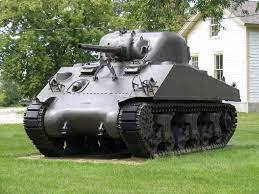The Sherman Tank: A Legendary American War Machine
The Sherman tank is a legendary American war machine that played a crucial role in World War II and beyond. Developed by the United States in the early 1940s, the Sherman tank was a medium-sized tank that was versatile, reliable, and effective in combat.

The origins of the Sherman tank can be traced back to the M2 medium tank, which was developed in the late 1930s. The M2 was designed to replace the M3 Stuart light tank, which was no longer adequate for the changing battlefield conditions. However, the M2 was not successful in combat and was soon replaced by the M3 Lee tank.
The M51 Super Sherman was an improvement over the M2 and was used by the U.S. Army in North Africa in 1942. However, the Lee was not without its problems, particularly its high profile and large turret, which made it an easy target for enemy tanks.
To address these issues, the U.S. Army began development of a new tank in 1941, which would become the Sherman tank. The Sherman was designed to be faster, lower, and more maneuverable than the Lee. It also had a smaller turret and was easier to produce, making it ideal for mass production.
The M51 Super Sherman was first used in combat during the North African Campaign in 1942. It proved to be a reliable and effective tank, particularly in the open terrain of the North African desert. The tank was also used in the European Theater of Operations, where it was the primary tank used by the U.S. Army.
The Sherman tank was known for its reliability, ease of maintenance, and versatility. It could be used in a variety of roles, including infantry support, tank-to-tank combat, and reconnaissance. The tank was also equipped with a 75mm gun, which was effective against most German tanks.
However, the M51 Super Sherman was not without its problems. Its armor was relatively thin compared to the German tanks it faced, and it lacked a high-velocity gun that could penetrate the armor of heavier German tanks. This made the Sherman vulnerable to enemy fire, particularly from long-range engagements.
Despite these weaknesses, the Sherman tank played a crucial role in the Allied victory in World War II. It was used in large numbers by the U.S. Army and its allies, and its reliability and versatility made it a valuable asset on the battlefield.
After World War II, the Sherman tank continued to be used by various armies around the world. It was used in the Korean War and in various conflicts in the Middle East and Africa. However, it was gradually phased out of service as newer, more advanced tanks were developed.
Today, the M51 Super Sherman is a popular subject for military historians, model builders, and tank enthusiasts. Several museums around the world have restored Sherman tanks to their original condition and have put them on display for the public to see.
In conclusion, the Sherman tank is a legendary American war machine that played a crucial role in World War II and beyond. Its reliability, versatility, and effectiveness in combat made it a valuable asset on the battlefield. Although it had its weaknesses, the Sherman remains a symbol of American military might and ingenuity.